Hidden and Important: What you need to know about Watch Casebacks
When designing watches, most if not all brands would put a lot of emphasis on the front or the “face.” It gets the bulk of attention, which is understandable as it is the part that shows you the time, AKA the whole point of wearing a watch. The caseback, hidden away when wearing your timepiece, will often be forgotten by the wearer - but this is the part where brands like to engrave important details which we will learn about in this article.
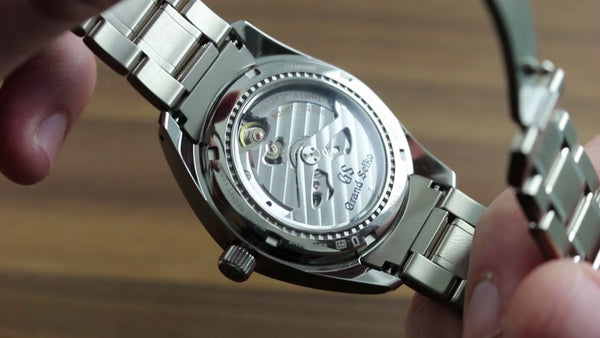
Not going to see a watch on IG shot this way. Source: Govberg Jewelers on YT
For Seiko modders, we may know of the caseback as just the part we remove to get access to the movement. But for watch brands, this is the blank canvas where they can feature some artwork, or add important details about the make and features of a watch. It can even be the perfect spot for people to customize their watch without necessarily changing any of the parts.
There are different kinds of casebacks aside from the screwdown caseback that we’re all familiar with from dealing with SKX watches. First, let’s look at these different kinds before getting into the nitty-gritty of common caseback information.
Different Kinds of Casebacks
Minimalist
Starting with the simplest one of the bunch, we have the minimalist casebacks which contain only the most essential information like the model number, or identifiers that will help you determine where and when the particular unit is manufactured.

A tool watch from the front to the back. Source: Watchuseek
Sinn watches are a good example of this as they primarily create tool watches that warrant a strict and simple design. Tools are meant to be functional, and so there is not much ‘artistic’ design that goes on in their casebacks, which only usually contain short and legible text that highlight the features of the watch such as its water resistance rating or resistance to magnetism.

What riches are hidden inside? Source: Millenary Watches
For a more minimalist caseback, look no further than the Rolex Submariner which only has a plain one with no engravings at all on the outside. It has a slight bevel and ribbing, making it look almost like a vault knob. Open it up though, and on the inside you’ll see the caseback engravings which, depending on the model, contains the Rolex branding and the part number.
And if you’re looking for a truly minimalist piece, we’re talking no engravings at all, you can check out our collection of SKX-style sterile casebacks that are a great fit for the SKX007, SKX009 and SKX013. They come in different colors and finishes but there is not a single engraving on them, making them the perfect choice for minimalist builds. You can even get our slim caseback to lower the profile of your Seiko mod.

Shave a few millimeters off your mod with this slim caseback
Crowded Caseback
On the other side of the spectrum, we have casebacks that are meant to impress - heavily designed pieces of steel that’s like an easter egg when one turns over the watch to see the back side. These casebacks are elaborately engraved and almost filled to the edges with art or information.
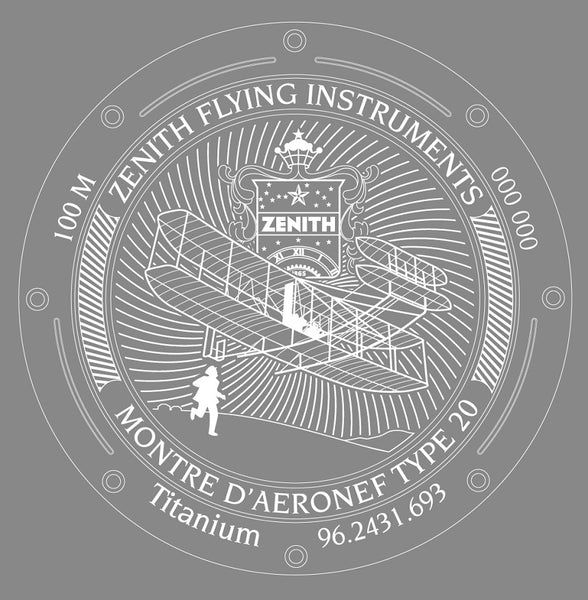
We wouldn't mind a crowded caseback if its crowded with art like this. Source: A Blog to Watch
One example is the Zenith Pilot Montre d’Aeronef Type 20 GMT 1903. It is a pilot watch released to pay tribute to the Wright Brothers who gave us the gift of flight by basically inventing airplanes. On the caseback is engraved the brand name, and the Kitty Hawk (the first manned plane by the Wright brothers) with a swirling background. The brand name and the name is again engraved along the edges along with the name of the watch. Truly a flashy design.

Blueprints are fascinating to look at, especially for aircrafts. Source: GMT Post
Another less crowded, yet flashy example is the Cartier Santos-Dumont Engraved Limited Edition watches, which again are made to pay tribute to the first movers in aviation in the early 19th century. The 4 watches in this LE line have all been engraved with some of the original sketches by Santos-Dumont himself. The watches themselves are a beauty, but the engraved casebacks are undoubtedly what make these models special.

Source: Pic Click
Representing diver’s watches is Seiko, and we need not look further than the SKX007. It may not be the most intricately designed Seiko caseback but aside from the text that can usually be found here (more details on this later in this article), we also have a beautiful wave logo at the center which symbolizes the watch’s water resistance. Many people believe that it is an iteration of the Great Wave of Kanagawa, but Seiko has neither confirmed nor denied this so we can all only guess.
Display or Exhibition Casebacks
Sometimes, the caseback really is just a window to the movement, or the engine that powers the watch. Some watch brands can be so proud of how luxurious they were able to make their calibres that they want to show it off by cutting out the middle of the caseback and replacing it with a see-through material, usually sapphire glass.
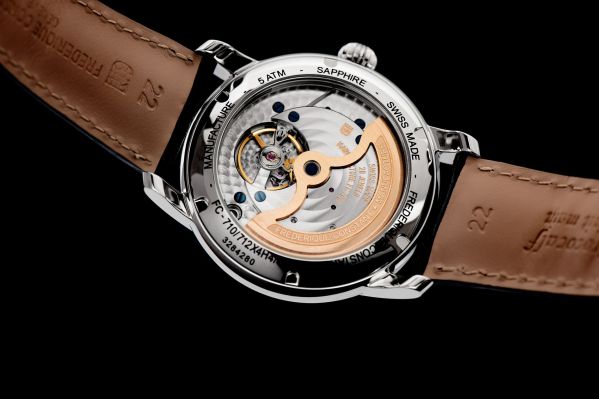
Not something you'd want to hide away from the public eye. Source: Master Horologer
There are many watches that fall under this category like the Armin Strom Skeleton Pure Water which gives a clear view of the multi-jeweled gears of its ARM09-S calibre, or the Frederique Constant Classics Moonphase Manufacture which does not have glass on the caseback but a hinge that opens up to reveal the solar system model-like movement.

Slim and see-through, what else do you need?
If you are looking for this type of caseback for your own Seiko mod, you can check out our own sapphire display casebacks that are perfect to show off the trusty NH35/36 workhorse from Seiko. If you blinged it up with some decorated rotors, then even better!
Personalized Casebacks
Some watches in history belonged to the infamous, increasing their value far beyond what the watch offers by itself. With simple inscriptions, they tell a fascinating story that is worth millions of dollars to some.
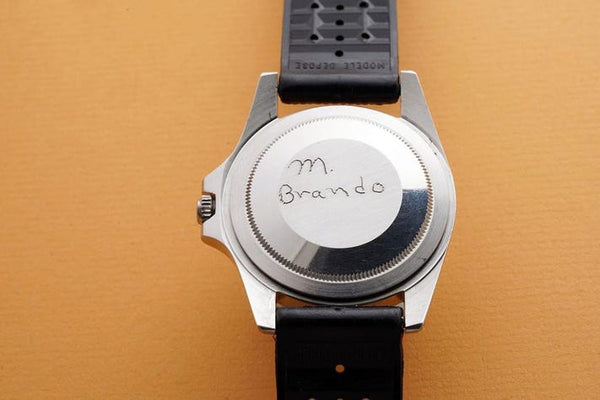
Step 1: Be famous. Step 2: Scribble name on back of watch. Step 3: Profit. Source: Forbes
One example is Marlon Brando’s self-engraved Rolex GMT Master Ref. 1675. He wore it on the set of Apocalypse Now despite pushback from the crew, to which he insisted that if people were focusing on his watch, then he is lacking in his part as an actor. Playing his role as Colonel Kurtz, he removed the bezel to give the watch a more beaten-up appearance while also scratching his name on the caseback. Note that he has no experience in professional engraving at this time making it look like it was scribbled by a child. This detail caused the watch to sell for $1.95 million in 2019.

No doubt, an appreciated gesture! Source: Forbes
Another storied actor is Paul Newman, who learned racing for a movie role which turned into a personal passion down the line. His sudden liking to a relatively dangerous hobby caused a bit of strain in his happy relationship with his wife and fellow actor Joanne Woodward. Still, Joanne expressed her support for Paul by gifting him a Rolex Daytona with the words “DRIVE CAREFULLY ME” as a reminder from his loving wife. It became the most expensive auctioned watch at $17.75 million back in 2020.

Keanu himself admitted that he was a Rolex man. Source: Telangana Today
Action movie fans are quite familiar with John Wick, played by the lovable Keanu Reeves. Spawning 4 movies so far, he is an internationally renowned assassin with long black hair and tasteful suits, and is one of Keanu's most memorable roles. At the wrap of the filming of John Wick 4, he gifted the stuntmen he worked with with a Rolex Submariner customized with the words “Thank you Keanu JW 4 2021.” Time will tell how much these would fetch at auctions in the future, but we do hope the stuntmen keep their watches for themselves as a gift from Keanu Reeves himself must be priceless.
The Information Found on a Seiko Caseback
Seiko loves to put a lot of information on their casebacks which tells us almost everything we need to know about that particular model. In 1969, Seiko’s internal company magazine Let’s Go Suwa No. 160 bared the meaning behind those strings of numbers found on the back of their watches. These are explained in groups:

Source: Plus9time
Case Material
Though commonly made of stainless steel, Seiko has a very long list of internally used material codes that are short and specific which helps pinpoint the make of a watch. Some of the most notable are below:
Format: Internal code - Meaning - What is stamped on the caseback
ATI - “All Titanium” - TITANIUM

Source: Hodinkee
ASILVER - “All Silver” - xxx SILVER / SILVER xxx
18KWG - 18 karat white gold case - 18KT
HSS - “Hard Stainless Steel” - STAINLESS STEEL
SILP - “Silver Plating” - SILP
SS18K - “Combined Stainless Steel and 18K Yellow Gold” - ST. STEEL + 18KT ST STEEL BACK
There's too many to include in this article. Check here for the full list.
Case Number
Check the back of your SKX007 and you would see an engraving saying “7S26 - 0020” - this is the case number. It is a combination of 2-4 digits (representing the caliber inside), a dash, and the design code. Used in conjunction, these form a unique case number.
The case number’s 4th character may stand for the different region where the watch was distributed and may also indicate the iteration of that particular case design.
Water Resistance Rating
Due to legislation changes in the US in the 70’s, it was forbidden to stamp the term “waterproof” on a watch because as we have tackled in a previous blog post, there aren’t really any true waterproof watches out there. By 1971, most if not all watches have switched to putting Water Resistant or just Water Resist on their cases to indicate its usability under water.
Serial Number
Up until 1969, Seiko used to have a 7 character serial number which followed the format: Month - Year - Production number. Some serial numbers switched up the month and year. By the 1970s, they switched to a 6 character serial number.
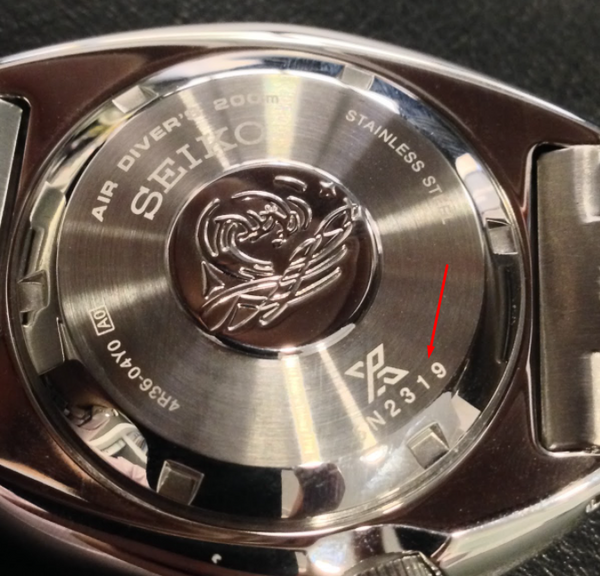
Source: Wrist Review
Seiko’s serial numbers are stamped this way:
1st digit - The year of manufacture. Since it is only a single digit, the decade when it was created will need to be deduced from other qualities of the watch such as the movement used inside (most movements are not in production for more than a decade), or the styling of the watch.
2nd digit - The month of manufacture. It can be 1-9 for the months January through September, then 0 for October, and N and D for November and December, respectively.
Last 4 digits - The production number that is unique to that unit or batch.
Note that this formatting does not apply to the recent Seiko 5 Sports line.
Case Manufacturer Code
Some Seiko watches may also contain a case manufacturer code, which pinpoints which factory made the case for the unit. Aside from local Japan factories, they also have a few overseas locations that may be making parts or even whole, assembled watches. When buying a JDM Seiko, you may see the code Japan-A or Japan-J, with a few also having -G, -X and -S suffixes.
Other Markings
Though not specifically indicative, a horseshoe symbol can be used to denote that the watch is resistant to magnetism, and may also have a bar under the horseshoe for standard resistance and 2 bars for enhanced.
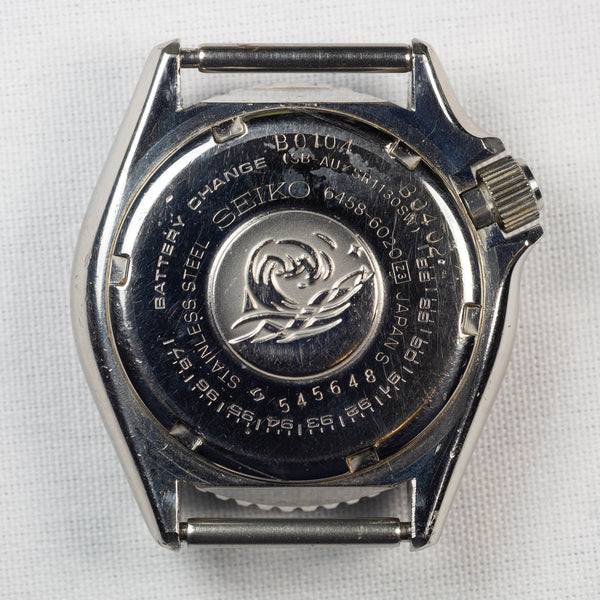
Source: Plus 9 Time
Seiko quartz divers may contain stamps on the caseback that will tell the user when the battery change is expected to be necessary. When the battery change is done, Seiko service centers will usually add a 5 character stamp on the caseback to indicate the year and month when the service was done.
Wrap Up
It can be a bit intimidating to try and decipher the codes on watch casebacks but learning the meaning of these codes can be fun and rewarding, especially for watches with a long history!
We hope you learned something new about your watch today, and feel free to add comments below if you have anything to add.
If you are in need of casebacks, do check out our collection here which can be used on any SKX style cases like the SKX007, SKX009 and SKX013.
Happy modding!
